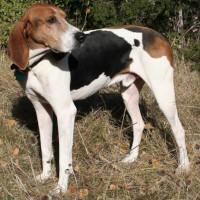Appearance of the Running Walker Foxhound
|
| This strain of American Foxhound is a solidly built dog with a body slightly longer than it is tall, and although it is not heavy, it has a well-muscled back and neck. His legs are strong and straight, and his hindquarters are also well muscled, enabling him to keep up with long-legged red foxes. The tail is moderately long, and can be straight, saber-shaped or slightly curved. Its head is of medium size, with a flat or slightly arched skull, and a strong, straight muzzle, both broad and deep, without wrinkles and with well-fitting lips. Its eyes can be of any color or shape, but the rims are always close-fitting and darkly pigmented. Their rounded, pendulous ears are generally set low and hang close to the sides of the head. They have a short, hard coat, lying close to the body, and can come in many colors, including orange and white, lemon and white, brown and white, black and tan, and tricolor. |
Temperament of the Running Walker Foxhound
|
| The Running Walker Foxhound is a tenacious dog with a strong instinctive urge to hunt and stalk, and is particularly good at tracking foxes and coyotes. He is dynamic and athletic in the field and can be a little too active and determined for some families, but he tends to be friendly, enthusiastic and even-tempered. He's generally people-oriented and eager to please, but he's difficult to house-train and has a short attention span, so short, varied training sessions are more effective. Interesting smells are often irresistible to Foxhounds, which can also hinder training efforts in some cases. Although generally agreeable with other dogs, their exceptionally high hunting instinct can make them unsuitable for multi-pet households, unless early socialization takes place. Without sufficient physical and mental activity, these dogs are prone to depression and may develop harmful or destructive behaviors, such as obsessive howling or chewing your property. |
Needs and activities of the Running Walker Foxhound
|
| These high-energy, tracker-type hounds need plenty of exercise to keep them fit and mentally stable. Hounds, especially active and working breeds, are prone to destructive bouts of depression when they haven't had enough exercise and mental stimulation. Long walks and runs are always appreciated and, in addition to fox and coyote hunting, the Running Walker Foxhound is also very good at tracking competitions. This is not a dog that will be comfortable or practical in an apartment, as its high activity level and distinctive howl can disturb other apartment dwellers. |
Maintenance of the Running Walker Foxhound
|
| The Running Walker Foxhound's coat is naturally weather-resistant and should only be bathed when necessary, as over-frequent bathing can rob the coat of its natural protective oils. Weekly brushing with a long-hair brush, stiff bristle brush or grooming glove will remove dirt and debris, control shedding and keep the coat healthy and shiny. Dogs with hanging ears, like most Foxes and Coonhounds, are more prone to ear infections than other dogs. So it's important to check them regularly to make sure they're clean, dry and odor-free. |







 English (United Kingdom)
English (United Kingdom)